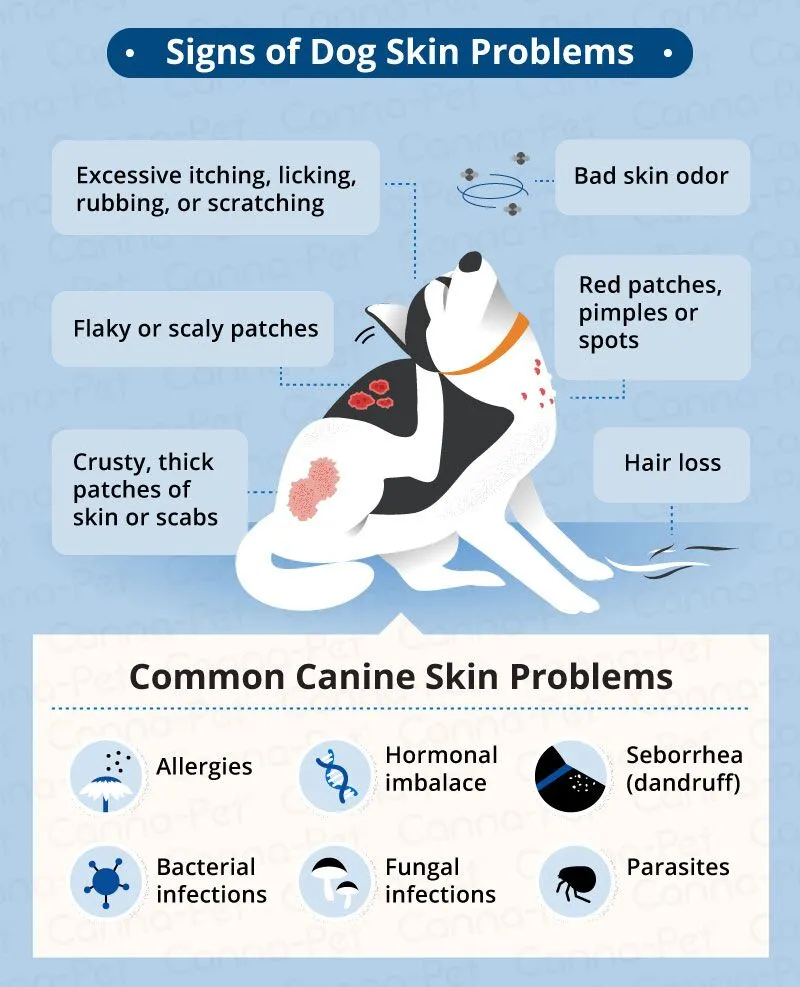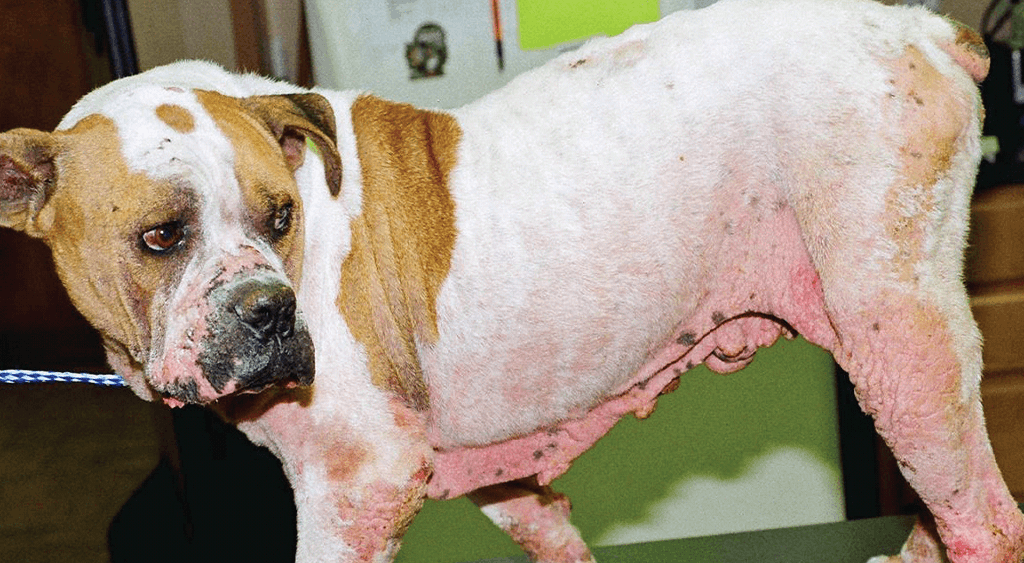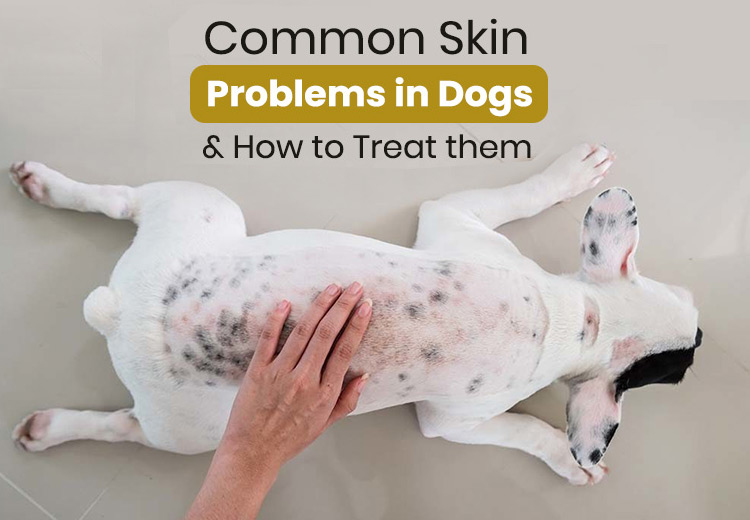Why Skin Problems Are So Common in Dogs
If you’ve ever noticed your dog scratching a little too much, licking their paws nonstop, or developing mysterious patches of dry skin, you’re not alone. Dog skin problems are incredibly common, and they can sneak up on even the healthiest pups. Just like people, dogs can have allergies, irritations, or reactions to their environment — but unlike us, they can’t tell us what’s bothering them. That’s why it’s so important to spot the signs early. The sooner you catch a skin issue, the easier it is to treat, and the less discomfort your dog has to endure. After all, a happy dog starts with healthy skin.
🐕🦺 What Causes Dog Skin Problems?
Understanding what causes dog skin problems is the first step to keeping your pup comfortable and healthy. Just like humans, dogs can suffer from a variety of skin issues — and many of them come from things we might not even realize. Here are the most common culprits behind those itchy, flaky, or irritated spots on your dog’s skin:

🦠 1. Allergies (Food & Environment)
Allergies are one of the top causes of skin issues in dogs. Your furry friend might be allergic to certain ingredients in their food — like beef, chicken, wheat, or dairy. But environmental triggers are just as common. Pollen, dust mites, mold, and even certain grasses can lead to itchy skin, redness, and hot spots. If your dog is scratching more during certain seasons, environmental allergies might be to blame.
🐛 2. Parasites (Fleas, Mites, Ticks)
Fleas are notorious for causing intense itching and skin irritation, especially in dogs with flea allergy dermatitis. But fleas aren’t the only pests to watch out for — mites (which cause mange) and ticks can also lead to serious dog skin problems, including infections, scabbing, and hair loss. Regular flea and tick prevention is a must for healthy skin.
🧫 3. Fungal or Bacterial Infections
When your dog’s skin is damaged — even by minor scratching — bacteria and fungi can take advantage. Bacterial infections like staph or fungal infections such as ringworm or yeast can cause redness, odor, scaly skin, and even pus-filled bumps. These conditions often require vet-prescribed treatments, especially if they spread quickly or worsen over time.
💨 4. Dry Skin or Poor Grooming
Dry air, frequent baths with harsh shampoos, or a lack of essential fatty acids in the diet can lead to dry, flaky skin. On the flip side, poor grooming can allow dirt, oils, and loose fur to build up, irritating the skin. Regular brushing and using a gentle, dog-specific shampoo can make a big difference in preventing dog skin issues.
🧠 5. Hormonal Imbalance or Stress
Skin problems in dogs can also stem from internal causes. Hormonal imbalances, such as those related to thyroid or adrenal glands, can affect coat quality and skin health. Additionally, dogs experiencing high levels of stress or anxiety often chew or lick their skin excessively, leading to raw spots and infections.
🐶 Most Common Dog Skin Problems: What Every Pet Owner Should Know
Noticing your dog scratching, biting, or licking more than usual? It could be more than just a passing itch. Many dogs deal with skin issues at some point in their lives — and some problems are far more common than you might think. From dry, flaky patches to red, irritated hot spots, dog skin problems can show up in a variety of ways and for a variety of reasons.
As a pet owner, knowing what these conditions look like (and what causes them) can help you spot issues early, provide relief faster, and prevent small problems from becoming big ones. Let’s take a closer look at the most common skin problems dogs face — and how to recognize them before they affect your dog’s health and happiness.
🐾 A. Itchy Skin (Pruritus)
Itchy skin — or pruritus — is one of the most common and frustrating dog skin problems for both pets and their owners. If your dog is constantly scratching behind their ears, licking their paws, or chewing at certain spots, it’s not just a quirky habit — it’s a sign that something’s irritating their skin.
Symptoms often include:
- Persistent scratching
- Excessive licking or biting
- Redness or inflamed patches
- Restlessness or trouble sleeping due to itching
The causes of itchy skin can vary, but the usual suspects include:
- Allergies: Dogs can develop allergic reactions to food, dust, pollen, or even cleaning products.
- Dry Skin: Low humidity, cold weather, or harsh shampoos can strip moisture from your dog’s skin.
- Parasites: Fleas, mites, or ticks are notorious for making dogs itch like crazy — even one flea bite can trigger a reaction.
🔴 B. Hot Spots (Acute Moist Dermatitis)
Hot spots, medically known as acute moist dermatitis, are one of the more alarming dog skin problems because of how quickly they appear and how uncomfortable they can be. These are red, inflamed, and often moist sores that seem to pop up overnight — and they can spread fast if not treated promptly.
You’ll usually spot a hot spot as a raw, irritated patch of skin that your dog just won’t stop licking, chewing, or scratching. The area may ooze, smell bad, or even lose fur around it. These painful spots often develop in response to:
- Persistent scratching or biting, usually due to fleas, allergies, or irritation
- Trapped moisture from swimming, bathing, or wet fur
- Poor grooming or underlying skin infections
Because dogs can’t resist the urge to fuss with a hot spot, it’s easy for the sore to become infected. Treatment usually involves cleaning the area, preventing further licking (using an e-collar if needed), and possibly a vet-prescribed antibiotic or anti-inflammatory. The key is acting quickly — the sooner you treat a hot spot, the less your dog suffers.
❄️ C. Dog Dandruff / Dry Skin
Just like humans, dogs can suffer from dandruff — those small, flaky white bits that show up in their fur and often come with dry, itchy skin. While it might seem like a minor issue, dog dandruff can actually be a sign that something’s off with your pup’s skin health.
You might notice:
- Flaky white or yellowish patches
- Dry, dull-looking coat
- More scratching than usual
- Flakes especially visible on darker fur
This type of dog skin problem is often linked to a few key causes:
- Poor grooming: Infrequent brushing can lead to a buildup of dead skin cells.
- Unbalanced diet: A lack of essential fatty acids or nutrients can dry out your dog’s skin.
- Weather changes: Cold, dry air (especially in winter) can strip moisture from their skin.
Sometimes dry skin is harmless and can be improved with regular grooming, moisturizing shampoos, and dietary supplements like omega-3s. But if the flakes are excessive or your dog seems uncomfortable, it’s worth a trip to the vet to rule out underlying issues like seborrhea or skin infections.
🌼 D. Skin Allergies (Atopic Dermatitis)
If your dog is constantly scratching, licking their paws, or developing red, irritated skin, they may be suffering from atopic dermatitis — a common form of dog skin problem caused by allergies. Just like humans, dogs can have allergic reactions to everyday things in their environment, and their skin often takes the hit.
Typical symptoms include:
- Red, inflamed skin
- Constant itching or licking
- Swelling, especially around the ears, paws, or belly
- Hair loss or scabbing from excessive scratching
These reactions can be triggered by:
- Pollen (from grass, trees, weeds)
- Dust mites or mold spores
- Certain foods like chicken, beef, dairy, or grains
- Household products like cleaners or air fresheners
Atopic dermatitis usually starts as seasonal itching but can become a year-round problem if left untreated. Managing it often requires a mix of approaches — like allergy testing, special diets, medicated baths, and in some cases, vet-prescribed treatments or allergy shots.
Catching skin allergies early can make a world of difference for your dog’s comfort and prevent more serious skin infections down the road.
🦠 E. Fungal & Bacterial Infections
When your dog’s skin barrier is weakened — from scratching, allergies, or wounds — it opens the door to fungal and bacterial infections, two common and often uncomfortable dog skin problems. These infections can spread quickly and may require medical treatment to fully heal.
Some of the most common infections include:
- Ringworm (a fungal infection that isn’t actually a worm!)
- Yeast infections, often found in ears, paws, or skin folds
- Staph infections, caused by bacteria entering small cuts or irritated areas
Symptoms to watch for:
- Patches of hair loss
- Scabs, crusty skin, or moist sores
- A strong, unpleasant odor from the affected area
- Greasy or discolored skin
These infections can make your dog incredibly uncomfortable, and in some cases, they can even be contagious — to other pets or humans. That’s why quick diagnosis and treatment are so important. A vet may prescribe antifungal or antibiotic medications, medicated shampoos, or topical creams depending on the cause.
🌿 Natural Remedies for Dog Skin Issues

If you’re looking for gentle, effective ways to ease your dog’s skin discomfort, nature has some amazing options. While it’s always a good idea to check with your vet first—especially for severe issues—many pet owners have found relief for their pups through simple, natural remedies. These treatments can help soothe itching, reduce inflammation, and even fight off bacteria and fungi, all without harsh chemicals.
Here are some of the most trusted natural remedies for dog skin problems:
🥥 1. Coconut Oil (Moisturizing & Antifungal)
Coconut oil isn’t just a kitchen staple — it’s also a skin-saver for dogs. When applied topically, it deeply moisturizes dry, flaky skin and can even help with minor fungal infections thanks to its natural antifungal properties. It’s especially great for dogs with dry elbows, cracked paws, or rough patches.
How to use: Rub a small amount onto affected areas or add a teaspoon to your dog’s food (check with your vet first for dosage).
🛁 2. Oatmeal Baths (Soothes Itch)
Nothing calms an itchy pup like a warm oatmeal bath. Oatmeal contains natural compounds that reduce inflammation and soothe irritated skin. It’s especially helpful for dogs with allergies, bug bites, or general itchiness.
How to use: Grind plain oats into a fine powder, mix into warm bath water, and let your dog soak for 10–15 minutes.
🍎 3. Apple Cider Vinegar Rinse (Fights Bacteria – Use Diluted)
Diluted apple cider vinegar can be a powerful natural disinfectant for your dog’s skin. It helps fight bacteria, yeast, and odor — especially useful for itchy paws or mild hot spots.
How to use: Mix equal parts apple cider vinegar and water in a spray bottle. Spray lightly on affected areas, avoiding any open wounds or broken skin.
🌱 4. Aloe Vera Gel (Natural Anti-Inflammatory)
Aloe vera is known for its cooling, soothing properties — and it works wonders on inflamed or irritated dog skin. It’s a natural anti-inflammatory that can provide immediate relief from itching or burning.
How to use: Use pure aloe vera gel (without added alcohol or fragrances) and apply a thin layer to the irritated area. Great for sunburns, minor rashes, or insect bites.
🐟 5. Omega-3 Supplements (Boost Skin Health)
Sometimes the best remedy comes from the inside out. Omega-3 fatty acids, found in fish oil, support healthy skin and reduce inflammation from allergies or chronic skin issues. They also promote a shinier, softer coat.
How to use: Add a high-quality omega-3 supplement to your dog’s meals — many come in liquid or capsule form. Always follow the dosing guidelines for your dog’s weight.
🏥 When to See a Vet
While many dog skin problems can be managed at home with gentle care and natural remedies, there are times when professional help is absolutely necessary. Skin issues that go untreated or worsen over time can lead to infections, pain, or even long-term health problems.
Here are some clear signs that it’s time to schedule a vet visit:
🔁 1. Persistent Itching
If your dog is scratching, licking, or chewing constantly, and nothing seems to help, it could be more than just dry skin or fleas. Persistent itching might signal allergies, infections, or underlying medical issues that need a vet’s attention.
🩸 2. Bleeding or Pus
Any skin issue that leads to open wounds, bleeding, or pus is a red flag. These symptoms suggest an infection or severe irritation that could get worse without proper treatment.
🐕🦲 3. Noticeable Hair Loss
Mild shedding is normal, but bald patches or areas where fur is falling out rapidly could point to a serious condition like mange, ringworm, or hormonal imbalances.
🤢 4. Foul Odor from the Skin
If your dog’s skin smells bad, it’s often a sign of bacterial or yeast infections. These can grow quickly and become painful, so don’t wait — get your pup checked out.
⏳ 5. No Improvement with Home Treatment
Tried natural remedies but still seeing no improvement after a few days? That’s your cue. If the skin problem isn’t getting better, or seems to be spreading, a vet can diagnose the root cause and offer a targeted treatment plan.
🛡️ Preventing Dog Skin Problems: Simple Steps for a Healthier Pup
When it comes to dog skin problems, prevention is always better than cure. The good news? A few simple habits can go a long way in keeping your dog’s skin healthy, itch-free, and protected year-round. Whether your pup has sensitive skin or you just want to stay ahead of issues, here are some practical, vet-approved ways to help prevent those pesky skin troubles before they start.
✂️ Regular Grooming
Routine brushing doesn’t just keep your dog looking good — it removes loose hair, dirt, and allergens while boosting healthy oil production on the skin. It also helps you spot skin issues early, before they become serious.
🧴 Use Hypoallergenic Shampoo
Bath time matters. Using a hypoallergenic, gentle dog shampoo can help avoid skin irritation caused by harsh chemicals or fragrances. Look for natural ingredients like oatmeal or aloe vera — and avoid overbathing, which can dry out the skin.
🦟 Keep Fleas & Ticks Under Control
Parasites like fleas and ticks are a leading cause of itching and skin infections. Use vet-recommended flea and tick preventatives regularly, and check your dog after walks or outdoor play.
🥩 Feed a Skin-Supportive Diet
Healthy skin starts from the inside out. Choose a high-quality diet rich in omega-3 fatty acids, vitamins, and proteins that nourish your dog’s skin and coat. If needed, ask your vet about adding fish oil or other supplements.
🧼 Keep Your Dog’s Environment Clean
A clean living space reduces exposure to allergens, bacteria, and pests. Regularly wash your dog’s bedding, vacuum the house, and avoid using harsh cleaning chemicals around your pet.
🐶 Final Thoughts: Don’t Ignore Dog Skin Problems
Dog skin problems are more than just an inconvenience — they can cause real discomfort and distress for your furry companion. From allergies and parasites to infections and dry skin, there are many potential causes behind that constant itching or patchy coat. The good news is, most of these issues are treatable — and even preventable — with the right knowledge and care.
By understanding the signs, acting early, and using a mix of proven treatments and natural remedies, you can help your dog heal faster and stay healthier in the long run. And don’t forget — regular grooming, a skin-friendly diet, and a clean environment go a long way in preventing dog skin problems before they start.
If home remedies aren’t helping, or symptoms get worse, always consult your vet. Your dog can’t tell you what’s wrong, but with your attention and love, you can make sure they feel their best — inside and out.


